





When the Italian Matteo Polli tackles a new design, he usually has one decisive focus in mind: the most favourable rating possible for the boat. Polli is regarded as one of the leading developers, particularly when it comes to measuring according to the ORC formula, and is currently setting the standards in the regatta scene with his successes. His track record is remarkable. Polli's palmarès includes several world and European championship titles with his designs for the Italia Yachts brand and the Italia 9.98, 11.98 and 12.98 types or with the ORC legend called M37, which Matteo Polli planned years ago with his then partner and now main competitor Maurizio Cossutti.
With the Grand Soleil 44 Performance for the new client Cantiere del Pardo, Matteo Polli has also been able to further polish up his impressive track record. The boat won the ORC World Championship in Class B in 2021 and successfully defended the title last year in 2022. The test of the Grand Soleil 44 Performance was published exactly two years ago in YACHT 2/2021. Now the new Grand Soleil 40 is set to build on the success of her bigger sister and pick up the trophies in the smaller ORC C class.
Grand Soleil 40 as the little sister of the 44
The design of the new 40 hardly differs from that of the 1.50 metre longer 44. Essentially, with marginal adjustments, the hull lines are the same with the same underwater appendages and a similar sail plan - everything has just been shrunk down a little. However, the new and smaller boat is significantly wider in comparison and in relation to the hull length. The aspect ratio (length to width) for the Grand Soleil 40 is 2.9, while the lines of her larger sister are significantly more elongated with a factor of 3.1.
This development is probably due less to an ultimate optimisation of dimensions than to the fact that the Grand Soleil 40 is not only intended to be a racing boat, but also a touring and family boat. The compromises in favour of space and comfort below deck also have to be right.
Two basic versions of the Grand Soleil 40
Accordingly, theGrand Soleil 40 with two versions to meet different requirements. In the standard version, the boat is designed as a simple performance cruiser to meet the needs of cruising or family sailors who like to be active on the boat and enjoy sporty sailing.
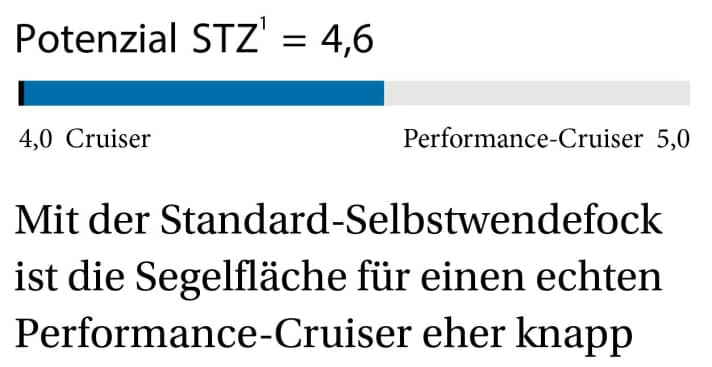
Under the designationGrand Soleil 40 Race the same boat is available as a designated regatta yacht with a strong focus on sport and performance. In this version, instead of the standard self-tacking jib, the racy Italian gets an overlapping genoa with hole points on the cabin superstructure, additional winches for guiding the genoa sheet, a longer bowsprit made of carbon fibre and, above all, a higher mast with rod shrouds and significantly more sail area.
Test impressions of the Grand Soleil 40 Race
The test boat provided to YACHT is build number one in the high-performance versionRace with the higher rig and overlapping genoa. In winds of between eight and ten knots (wind force three), the Grand Soleil 40 gets off to a good start. The log shows a speed of 6.4 knots at a true wind angle of 40 degrees. A rollable Code Zero provides a considerable increase in performance from a wind angle of 70 degrees. At half wind, the boat quickly reaches wind speed. For deeper courses, however, the Code Zero is no longer adequate. A gennaker would then be more efficient, but was unfortunately not available on the test boat. Regatta sailors can also equip the boat with a conventional spinnaker for simple linear courses (upwind-downwind) and dispense with the very long bowsprit, which favours measurement.
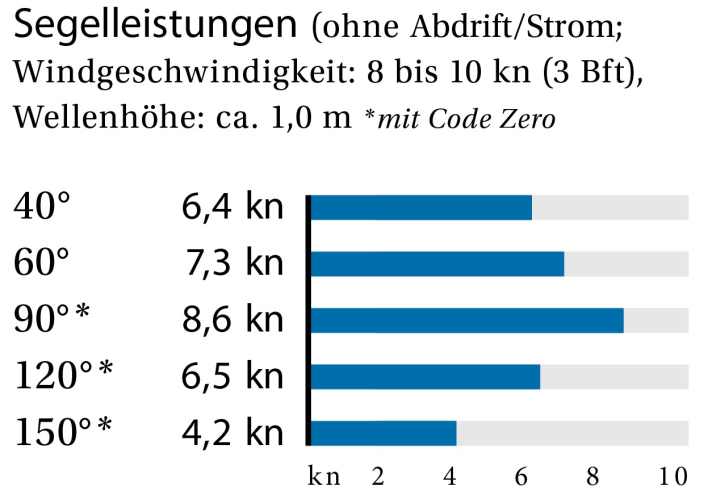
The rig of the Grand Soleil 40
The aluminium rig from Sparcraft with two spreaders is positioned on the keel of the Grand Soleil 40 and relatively far aft. The self-tacking jib in particular benefits from the long J-measurement, as it is still large enough and sufficiently efficient even in light winds.
The keels of the Grand Soleil 40
The standard keel is a slim cast iron profile with a bolted and antimony-hardened lead bulb. The keel of the Race version is slightly shorter (2.10 metres draught), but provides more stability thanks to a lower centre of gravity with less weight overall. This is possible because the keel shaft is made of a stainless steel frame encased in GRP half-shells instead of cast iron. However, regatta sailors have to pay almost 14,000 euros extra for this.
The rudder of the Grand Soleil 40
On the wind, the Grand Soleil 40 showed very lively and manoeuvrable sailing characteristics in the test. Because designer Matteo Polli is known not to be a fan of double rudder blades, the slim but relatively deep steering fin is built far below the wide stern in order to be fully effective even when heeling heavily. Experienced sailors will be pleased with the very neutrally tuned steering with a very light but still easily perceptible rudder pressure.
Steering and trimming on the Grand Soleil 40
The helmsman sits sideways on the running deck in a very low position. The seat height here is just 33 centimetres above the cockpit floor. This position is uncomfortable and tiring over time, especially for taller helmsmen. There are also no footrests for support when heeling. And it is difficult for the seated helmsman to see forwards and into the sails. To avoid this problem, the helmsman has to stand. Unfortunately, the mainsheet trimmer sits in front of the steering column with little room to manoeuvre and very close to the winch, so that he cannot work with the crank handle without restriction.
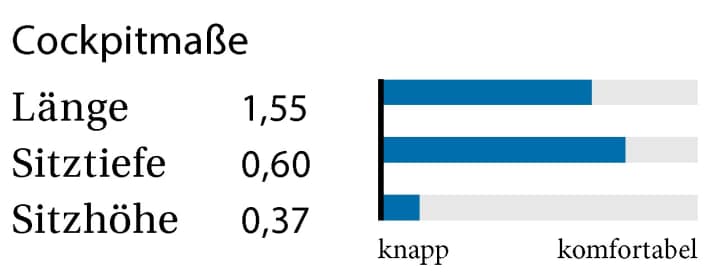
In the wide and open cockpit, the co-sailors have plenty of space to work and relax, but also look for support when heeling. A sturdy cockpit table for support is therefore useful for touring sailing, which is available as an option at an extra charge. For sailors who want to use the boat for both cruising and racing, a table is also available in an easily removable version.
Bathing platform as standard
The Grand Soleil 40 is delivered from the shipyard with a folding bathing platform. It opens electrically at the touch of a button. A closed storage space for the life raft is also integrated in the stern, but this can only be accessed via the open tailgate. If the island is needed in an emergency, this can be problematic under certain circumstances.
No baking boxes
There is room for many things in the large, spacious aft storage space, including additional sails and all the fenders. To achieve this, the shipyard has dispensed with the forecastle boxes under the seat thwarts in favour of more volume and a greater sense of space in the aft cabins - a compromise. However, there is a complete lack of storage space for small items on deck. The controls are also easily accessible through the aft peak. A single, continuous cable and chain hoist connects the quadrant of the single rudder with the two steering columns. The autopilot also accesses the chain directly, but not the quadrant. This means that there is no redundancy. If the control cable or the deflections for the cables become defective, the only option is to use the emergency tiller to solve the problem.
The Grand Soleil 40 below deck
A galley built lengthways into the saloon is generally rather unusual for performance cruisers, and even an absolute exception in the 40-footer class. The relatively full-bodied hull shape of the new Grand Soleil 40 allows such an arrangement for the interior design without making too many compromises. In fact, the layout is particularly attractive in this case because it opens up the boat spatially and significantly increases the feeling of space.
Galley installed lengthways
The long galley line offers many advantages for cruisers: plenty of storage space, large work surfaces and plenty of room for two people to work. The seating area on the opposite side offers space for up to six people thanks to the central seat in the passageway. The table can be folded out and can also be lowered. An additional bunk (1.90 x 1.30 metres) would be possible here with an additional cushion. However, the table is very wobbly on one leg.
The forecastle
The central, partially free-standing berth in the foredeck is also more suited to a real cruising boat than a performance cruiser. With a width of 1.50 metres at the shoulders, the berth is still large enough for two people. Buyers of a Grand Soleil 40 can choose whether they would like to have an additional toilet room installed in the foredeck in addition to the wet room aft. The space for this is available without having to sacrifice lying or standing space. The standard boat has a large and partially accessible cupboard in the same place.
The aft cabins
The two aft cabins are the same size and furnished identically. With a width of more than 1.50 metres at the shoulders, the berth is also suitable for double occupancy. The space at the rear at the feet is quite narrow due to the panelling of the rudder shaft, which is built far forward. There is less than a metre of width available there. Thick, but also heavy mattresses ensure a high level of comfort in the cabins and are made in one piece, which is definitely an advantage for sleeping. In the foredeck, however, they make access to the storage spaces below the berths difficult. Two cushions divided lengthways would be more functional.
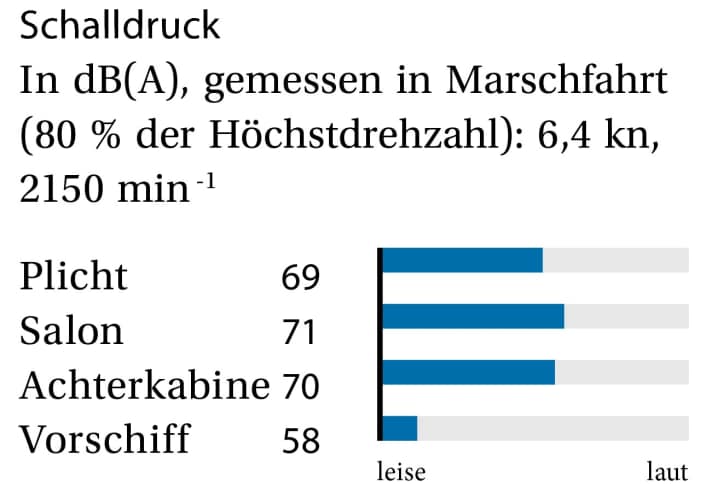
Stowage spaces on the Grand Soleil 40
Apart from the galley, the storage space below deck is generally not exactly plentiful. The saloon in particular lacks cupboards and drawers for small or larger items. The spaces below the sofa are also only available to a limited extent because the batteries, boiler and, if required, the heating or air conditioning are installed there. There are open shelves on the sides, which are pretty but hardly really useful. But there are plus points for the many and well-placed handholds in the boat. Solid handrails, grab rails and recessed grips ensure safety.
Quality and price of the Grand Soleil 40
The neatly finished and robust-looking interior below deck with its many solid wood parts is also pleasing. The interior components fit together perfectly, there are no inconsistent gaps, and there are no creaking noises even when the boat is heeled or in the shaft.
The price tag for the new Grand Soleil 40 is €395,000 gross, for the basic version of the boat ex shipyard and still without the sail wardrobe, which the customer determines individually. That's a lot of money for a 40-footer, even compared to the current competition. And the high price is once again proof of how prices are generally developing in the entire industry: sharply rising.
Nonetheless, with the new 40, Grand Soleil has launched a well thought-out, no-frills performance boat onto the market that essentially doesn't have much wrong with it. The pretty Italian will soon be making her debut at the boot trade fair in Düsseldorf,Hall 16, Stand C40. A visit on board is definitely worthwhile.
Review of the Grand Soleil 40
Beautiful performance cruiser from Italy with a strong focus on favourable measurement according to ORC or IRC. The boat is also highly customisable and very versatile. However, the price is high, even compared to the competition
Design and concept
- + High willingness to compromise
- + Available in two versions
- + Robust construction
- - Comparatively high price
Sailing performance and trim
- + Very balanced control
- + High performance potential
- - Low seating position on the bike
- - Little space for tall ships
Living and finishing quality
- + Robust construction, lots of solid wood
- + Open, bright layout in the lounge
- + Functional pantry line
- - Little storage space in the saloon
Equipment and technology
- + High-quality basic equipment
- + variance for rig and keels
- + Bathing platform as standard
- - Control without redundancy
The Grand Soleil 40 in detail
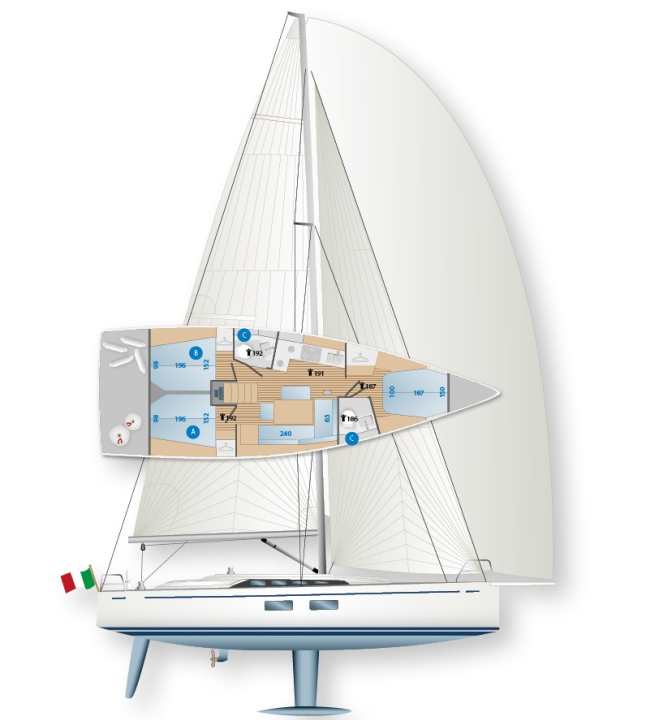
Technical data
- CE design category A
- Hull length 11.90 m
- Total length 12.90/13.60 m
- Waterline length 10.80 m
- Width 4.07 m
- Draught/altern. 2,40/2,10/1,85 m
- Mast height above WL (Std.) 17.67 m
- Theoretical hull speed 8.0 knots
- Weight 7.5 tonnes
- Ballast/proportion 2.5 t/33 %
- Mainsail 46.0 m2
- Self-tacking jib 38.0 m²
- Genoa (108 %) 45.0 m²
- Engine (Volvo P.) 20 kW/27 hp
- Fuel tank (PVC) 170 litres
- Fresh water tank (PVC) 300 litres
- Holding tanks 2x 30 litres
Hull and deck construction
- GRP sandwich constructions with PVC foam core (Airex) and vinyl ester resin. Carbon fibre reinforcements in highly stressed areas
Equipment and prices
- Base price ex shipyard € 395,080
- Standard equipment included: engine, sheets, railing, navigation lights, battery, compass, cushions, galley/cooker, bilge pump, toilet, fire extinguisher, electric cooler, holding tank with suction system
- For an extra charge: sails (main and headsail) €25,140, sailcloth €1,965, anchor with chain, fenders and mooring lines in a package €2,570, antifouling with epoxy primer €5,545,
- clear sailing handover € 8,260
- Price ready to sail € 438,560
- Warranty/against osmosis 2/2 years
Surcharge for comfort equipment
- Line-adjustable hollow points € 3,830
- Traveller with line guide € 4,295
- Electric anchor windlass incl.
- Tube kicker incl.
- Backstay tensioner incl.
- Jumping cleats 740 €
- Sprayhood € 4,690
- Teak in cockpit incl.
- VHF radio electrical package
- Log and echo sounder electric package
- Wind measuring system electrical package
- Autopilot electric package
- Electric package €18,885
- Charger incl.
- Shore connection with RCD incl.
- 230 volt socket (one) incl.
- 12-volt socket in the sat nav incl.
- Heating € 9,045
- Pressurised water system incl.
- Hot water boiler incl.
- Shower WC room incl.
- Cockpit shower incl.
- Comfort price € 480,045
Included in the price:
- Electrically folding bathing platform
- Headsail furling system (below deck)
- T-keel with lead ballast
Rig and sail
The aluminium rig from Sparcraft with two spreaders is standard. The performance mast is 90 centimetres higher and is fitted with rod shrouds. The surcharge is just under 13,000 euros. All sails are optional according to choice and requirements.
Machine
Standard Volvo Penta D1-30 with saildrive and 3-blade fixed pitch propeller. Upgrade D2-50 possible. Folding propeller only at extra cost.
Batteries
AGM batteries are installed ex shipyard, 3 x 90 AH (consumer), 1 x 70 AH (starter battery engine)
Deck equipment
Self-tailing winches from Harken as standard: 2 x 40.2 on the companionway, 2 x 46.2 aft. 2 x 50.2 primary winches additionally in the race version
Shipyard
Cantiere del Pardo, 47122 Forli (Italy); www.grandsoleil.net
Distribution
Diamond Yachts, D-24235 Laboe; www.diamond-yachts.de
Fast, strong and ready to compromise: the competition
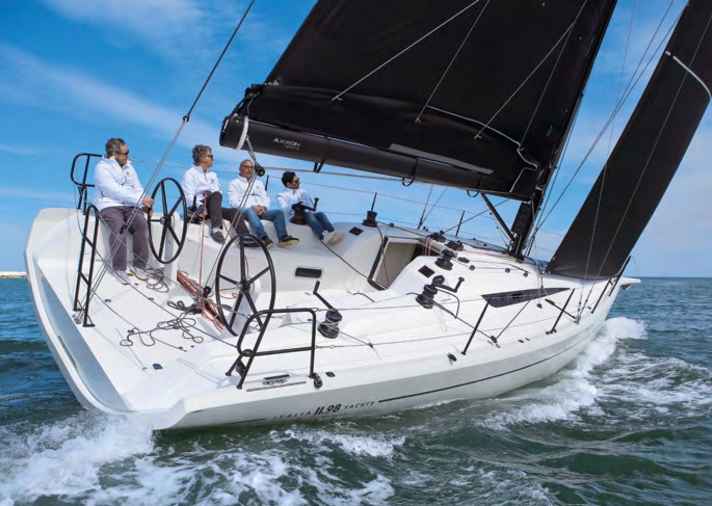
Italia 11.98
Fast and successful regatta boat with a strong measurement optimisation according to ORC and IRC. The design also comes from Matteo Polli.
Hull length 11.65 m; width 3.9 m; from 326,400 euros
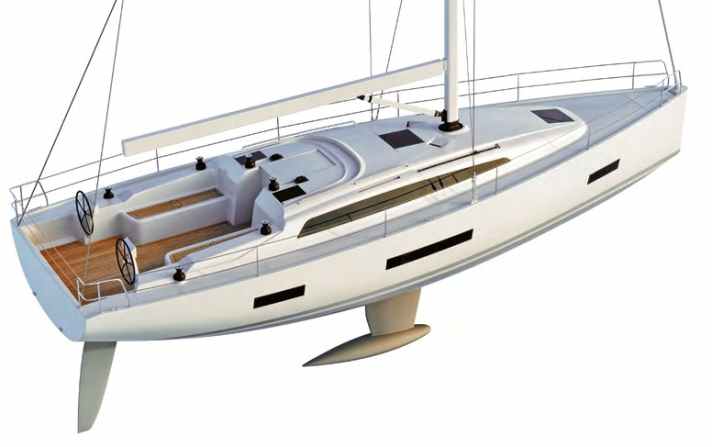
Salona 39
The complete overhaul of the Salona 380 is currently still under construction. The design comes from the studio of Maurizio Cossutti. Two or three cabins are possible.
Hull length 11.60 m; width 3.72; from 242,760 euros
YACHT test: follows
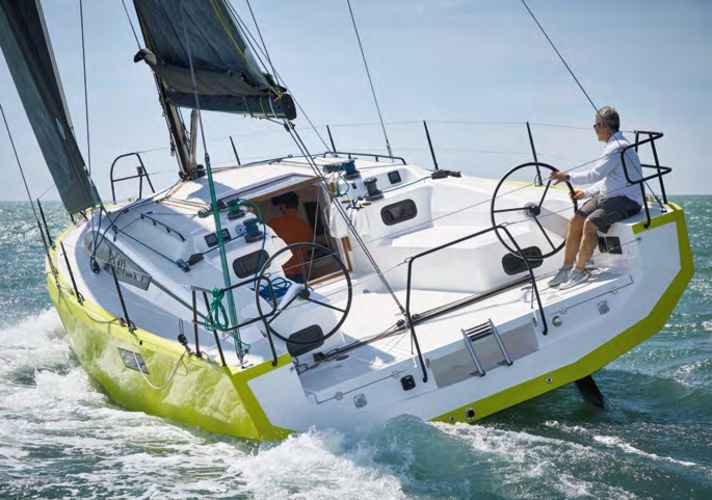
RM 11.80
Extremely versatile performance cruiser from France. The very wide hull is made of plywood, the deck of GRP. Available with fixed or swivelling keel.
Hull length 11.80 m; width 4.37 m; from 323,600 euros
YACHT test: Issue 20/2019
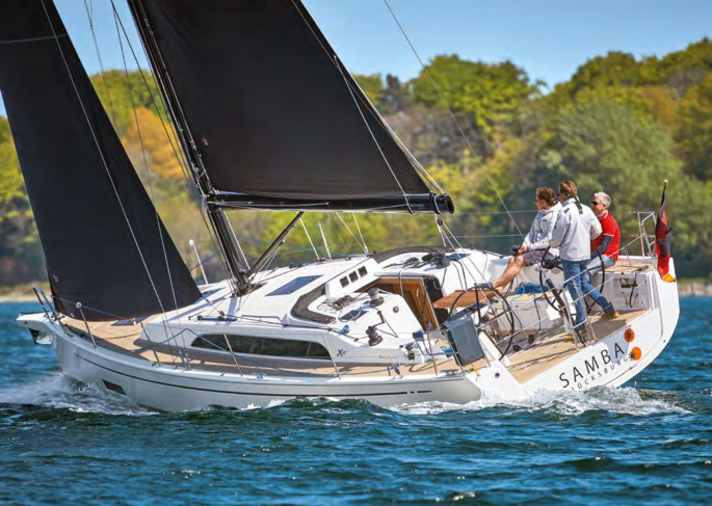
X 4.0
Currently the smallest boat in the X-Yachts programme in Denmark. A good compromise between cosiness and performance. Very well built and equipped.
Hull length 11.50 m; width 3.81 m; from 392.8 Euro

